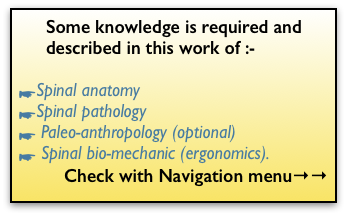It is hoped that this may provide a resource for designers and users of work chairs. There is a large body of research and background, on spinal bio-mechanics, which you may wish to explore.
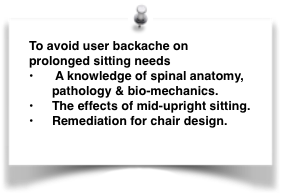 OBJECT. To identify and address the adverse bio-mechanic (ergonomic) factors that potentially were liable to result in spinal component break down which can account for Low Back Pain (LBP, backache and more serious disorders, IDD, CTD.) in relation to the seated posture,
OBJECT. To identify and address the adverse bio-mechanic (ergonomic) factors that potentially were liable to result in spinal component break down which can account for Low Back Pain (LBP, backache and more serious disorders, IDD, CTD.) in relation to the seated posture,
METHOD. Existing work on spinal pathology and biomechanics related to upright seated posture was explored.
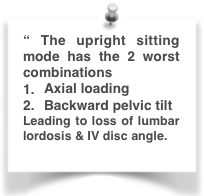 CONCLUSION. The evidence identified adverse effects which occur with conventional prolonged mid-upright sitting that required remediation. It was found that a reclined mode is the only position that avoids all the adverse effects of prolonged upright sitting. This conclusion became validated by independent work using pMRI scanning (Smith 2007).
CONCLUSION. The evidence identified adverse effects which occur with conventional prolonged mid-upright sitting that required remediation. It was found that a reclined mode is the only position that avoids all the adverse effects of prolonged upright sitting. This conclusion became validated by independent work using pMRI scanning (Smith 2007).
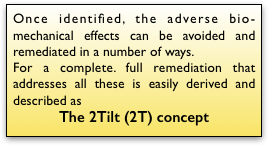 Anatomy→
Anatomy→- Biomechanics→
- Paleo Anthropology→
- Comments on chair design→
- Remediation to avoid LBP→
- The 2Tilt concept, the ultimate remediation→
The 2 TILT chair CONCEPT.
The big story here, however, is that it was found that a reclined mode is the only position that avoids all the adverse effects of prolonged upright sitting. For a reclined office work-chair to be practical a number of requirements are essential. These have been covered in the 2Tilt concept which was tested for practicality in the Cambridge MfI department.
 The 2T concept addresses all the ergonomic factors that ensure a sitting position that is the least likely to perpetuate, or result in, backache and other spinal conditions. It also includes the necessary requirements to make this a user-friendly practical work-chair. Comfort → is also thereby maximised.
The 2T concept addresses all the ergonomic factors that ensure a sitting position that is the least likely to perpetuate, or result in, backache and other spinal conditions. It also includes the necessary requirements to make this a user-friendly practical work-chair. Comfort → is also thereby maximised.
The 2T concept is fully described by following ☛A Full solution→
4. This leads on to the QuadriModal 4M work-station→.
Navigation.
The menu on the right→ indicates the layout and lists more posts than the main top menu. Next ☛ How to use this work →
Managing the Ergonomics of Office Seating
by John Jukes The Source Publishing Company Limited
Ergonomics expert John Jukes asks is the Sit/Stand desk the answer to aches and pains in the office?
Research done by Dr Henry Sanford, Orthopaedic Consultant at the Cromwell Hospital, adds another dimension to the problem of ergonomic comfort in the office. Sitting in a semi reclined position at 45 degrees reduces the gravitational loading on the spine by 50%. This is similar to the astronaut position, which permits working under heavy G forces. A suitable headrest and positioning of keyboard and VDU screen makes this a perfectly practical working position without inducing sleep. Many programmers, CAD users, control room engineers and tall people are seen to adopt this position using an ordinary chair when working for long periods – perching the tail on the front edge of the chair with their shoulder on the back and the legs out straight.
Sit/stand desks and pelvic support semi recline seating in the UK have yet to become part of the normal office landscape. When they do there will be several million office workers that will be grateful to be free from daily debilitating pain.
He wrote
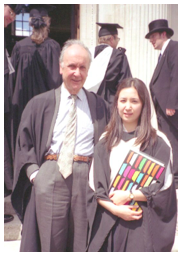 Dr Henry Sanford MA. MB. B Chir. (Cantab) D Phys Med. (Lond) is a well known Consultant Orthopaedic Physician in London and Associate Consultant to the Department of Rheumatology, St Thomas’s Hospital, SE1. Earlier he worked at St Thomas’s with Dr J H Cyriax who is regarded as the ‘Father’ of Orthopaedic (or Musculo-skeletal) Medicine after following 2 years in the army finishing as a Captain in the RAMC.
Dr Henry Sanford MA. MB. B Chir. (Cantab) D Phys Med. (Lond) is a well known Consultant Orthopaedic Physician in London and Associate Consultant to the Department of Rheumatology, St Thomas’s Hospital, SE1. Earlier he worked at St Thomas’s with Dr J H Cyriax who is regarded as the ‘Father’ of Orthopaedic (or Musculo-skeletal) Medicine after following 2 years in the army finishing as a Captain in the RAMC.
He was a founder member of the Society of Orthopaedic Medicine (SOM), the British Society of Musculo-skeletal Medicine (BIMM) and was Chairman of the Cyriax Organisation.. He has run courses and lectured internationally John Jukes – 30/07/2001 ☛Site Navigation→
![]()

